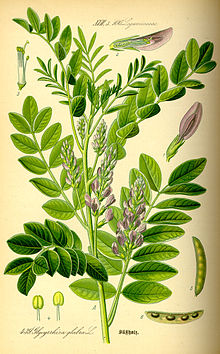
Back Soethout Afrikaans Lakritze ALS Glycyrrhiza glabra AN عرقسوس Arabic عرقسوس ARZ যষ্টিমধু Assamese Glycyrrhiza glabra AST Şirinbiyan Azerbaijani شیرین بیان AZB Татлы тамыр Bashkir
| Liquorice | |
|---|---|

| |
| Scientific classification | |
| Kingdom: | Plantae |
| Clade: | Tracheophytes |
| Clade: | Angiosperms |
| Clade: | Eudicots |
| Clade: | Rosids |
| Order: | Fabales |
| Family: | Fabaceae |
| Subfamily: | Faboideae |
| Clade: | Inverted repeat-lacking clade |
| Genus: | Glycyrrhiza |
| Species: | G. glabra
|
| Binomial name | |
| Glycyrrhiza glabra | |
| Synonyms[2][3][4] | |
| |
Liquorice (British English) or licorice (American English; IPA: /ˈlɪkərɪʃ, -ɪs/ LIK-ər-ish, -iss)[5][6] is the common name of Glycyrrhiza glabra, a flowering plant of the bean family Fabaceae, from the root of which a sweet, aromatic flavouring is extracted.[7]
The liquorice plant is an herbaceous perennial legume native to Western Asia, North Africa, and Southern Europe.[1] Liquorice is used as a flavouring in confectionery, tobacco, beverages, and pharmaceuticals, and is marketed as a dietary supplement.[7][8]
Liquorice extracts have been used in herbalism and traditional medicine.[7] Excessive consumption of liquorice (more than 2 mg/kg [3.2×10−5 oz/lb] per day of pure glycyrrhizinic acid, a key component of liquorice) can lead to undesirable consequences. Clinically, it is suspected that overindulgence in liquorice may manifest as unexplained hypertension, low blood potassium levels (hypokalemia), and muscle weakness in individuals.[7][8][9] Consuming liquorice should be avoided during pregnancy.[8]
- ^ a b "Glycyrrhiza glabra". Germplasm Resources Information Network. Agricultural Research Service, United States Department of Agriculture. Retrieved 6 March 2008.
- ^ "The Plant List: A Working List of All Plant Species". Retrieved 2017-03-07.
- ^ "Glycyrrhiza pallida Boiss., Diagn. Pl. Orient. ser. 2, 2: 22 (1856)". The International Plant Names Index. Retrieved 2017-03-07.
- ^ "Glycyrrhiza violacea Boiss., Diagn. Pl. Orient. ser. 2, 2: 23 (1856)". The International Plant Names Index. Retrieved 2017-03-07.
- ^ "Liquorice". Dictionary.com Unabridged (Online). n.d.
- ^ "Licorice". Dictionary.com Unabridged (Online). n.d.
- ^ a b c d "Licorice root". National Center for Complementary and Integrative Health, US National Institutes of Health. August 2020. Retrieved 11 June 2023.
- ^ a b c "Licorice". Drugs.com. 31 January 2022. Retrieved 11 June 2023.
- ^ Cite error: The named reference
omarwas invoked but never defined (see the help page).
© MMXXIII Rich X Search. We shall prevail. All rights reserved. Rich X Search